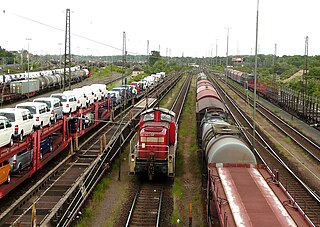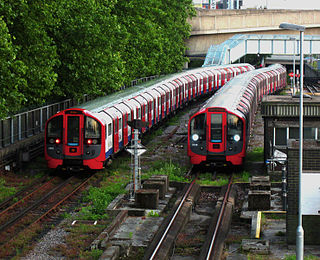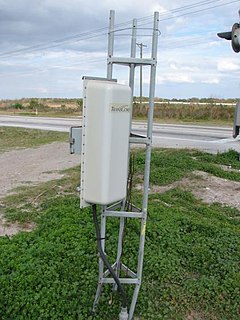
The term rolling stock in the rail transport industry refers to railway vehicles, including both powered and unpowered vehicles, for example locomotives, railroad cars, coaches, private railroad cars and wagons. A connected series of railway vehicles is a train.

The Association of American Railroads (AAR) is an industry trade group representing primarily the major freight railroads of North America. Amtrak and some regional commuter railroads are also members. Smaller freight railroads are typically represented by the American Short Line and Regional Railroad Association (ASLRRA), although some smaller railroads and railroad holding companies are also members of the AAR. The AAR also has two associate programs, and most associates are suppliers to the railroad industry.

The London Underground 1973 Stock is a type of rolling stock used on the Piccadilly line of the London Underground. It was introduced into service in 1975 with the extension of the line to Hatton Cross, followed by a further extension to Heathrow Central in 1977.

London Underground rolling stock includes the electric multiple units that run on the London Underground. The trains come in two sizes, smaller deep-tube trains and larger sub-surface trains that are of a similar size to those on British main lines. New trains are designed for the maximum number of standing passengers and for speed of access to the cars.

BEML Limited, previously Bharat Earth Movers Limited, is an Indian Public Sector Undertaking, with headquarters in Bengaluru, Karnataka, India. It manufactures a variety of heavy equipment, such as that used for earth moving, transport and mining.

Automatic equipment identification (AEI) is an electronic recognition system in use with the North American railroad industry. Consisting of passive tags mounted on each side of rolling stock and active trackside readers, AEI uses RF technology to identify railroad equipment while en route.
A rugged, or ruggedizedcomputer is a computer specifically designed to operate reliably in harsh usage environments and conditions, such as strong vibrations, extreme temperatures and wet or dusty conditions. They are designed from inception for the type of rough use typified by these conditions, not just in the external housing but in the internal components and cooling arrangements as well.
Metrowagonmash is an engineering company in Mytishchi, Russia. Metrowagonmash (MWM) is one of the leading enterprises in Russia operating in the field of transport machine building. It specializes in development, designing and manufacturing of rolling stock for metro systems and railways. Metrowagonmash is part of Transmashholding.

The Cape Town Convention on International Interests in Mobile Equipment, or Cape Town Treaty is an international treaty intended to standardize transactions involving movable property. The treaty creates international standards for registration of contracts of sale, security interests (liens), leases and conditional sales contracts, and various legal remedies for default in financing agreements, including repossession and the effect of particular states' bankruptcy laws.
Electronically controlled pneumatic brakes are a type of modern railway braking system which offer improved performance compared to traditional railway air brakes.

The railcar couplers or couplings listed, described, and depicted below are used worldwide on legacy and modern railways. Compatible and similar designs are frequently referred to using widely differing make, brand, regional or nick names, which can make describing standard or typical designs confusing. Dimensions and ratings noted in these articles are usually of nominal or typical components and systems, though standards and practices also vary widely with railway, region, and era. Transition between incompatible coupler types may be accomplished using Dual or Compromise couplings or a Barrier wagon.

The Rhaetian Railway Be 4/4 is a class of 11 kV 16.7 Hz AC metre gauge railcars operating under the traffic numbers 511–516 on the so-called core network of the Rhaetian Railway (RhB), which is the main railway network in the Canton of Graubünden, Switzerland.
The train communication network (TCN) is a hierarchical combination of two fieldbus for data transmission within trains. It consists of the Multifunction Vehicle Bus (MVB) inside each vehicle and of the Wire Train Bus (WTB) to connect the different vehicles. The TCN components have been standardized in IEC 61375.

From time to time, a railway decides that it needs to upgrade its coupling system from one that is proving unsatisfactory, to another that meets future requirements. This can be done gradually, which can create many problems with transitional incompatibilities, or overnight, which requires much planning.

Buffers and chain couplers are the de facto UIC standard railway stock coupling used in the EU and UK, and on some surviving colonial railways, such as in South America and India. These couplers are an assembly of several devices: buffers, hooks and links or screws.

EN 15227 is a European standard about the crashworthiness requirements for railway vehicle bodies. It was first resolved in 2008 and it is binding since 2012 for all new vehicles in the European Union.

Titagarh Wagons is a railway wagon manufacturer based out of Titagarh, West Bengal, India. The company manufactures coaches for the Indian Railways, bailey bridges, and mining equipment. A subsidiary, Titagarh Marines, operates in the shipbuilding industry.










